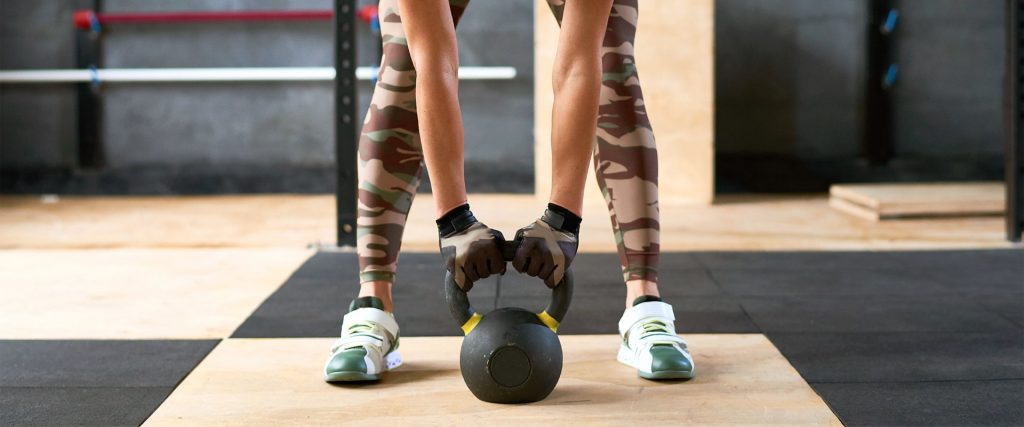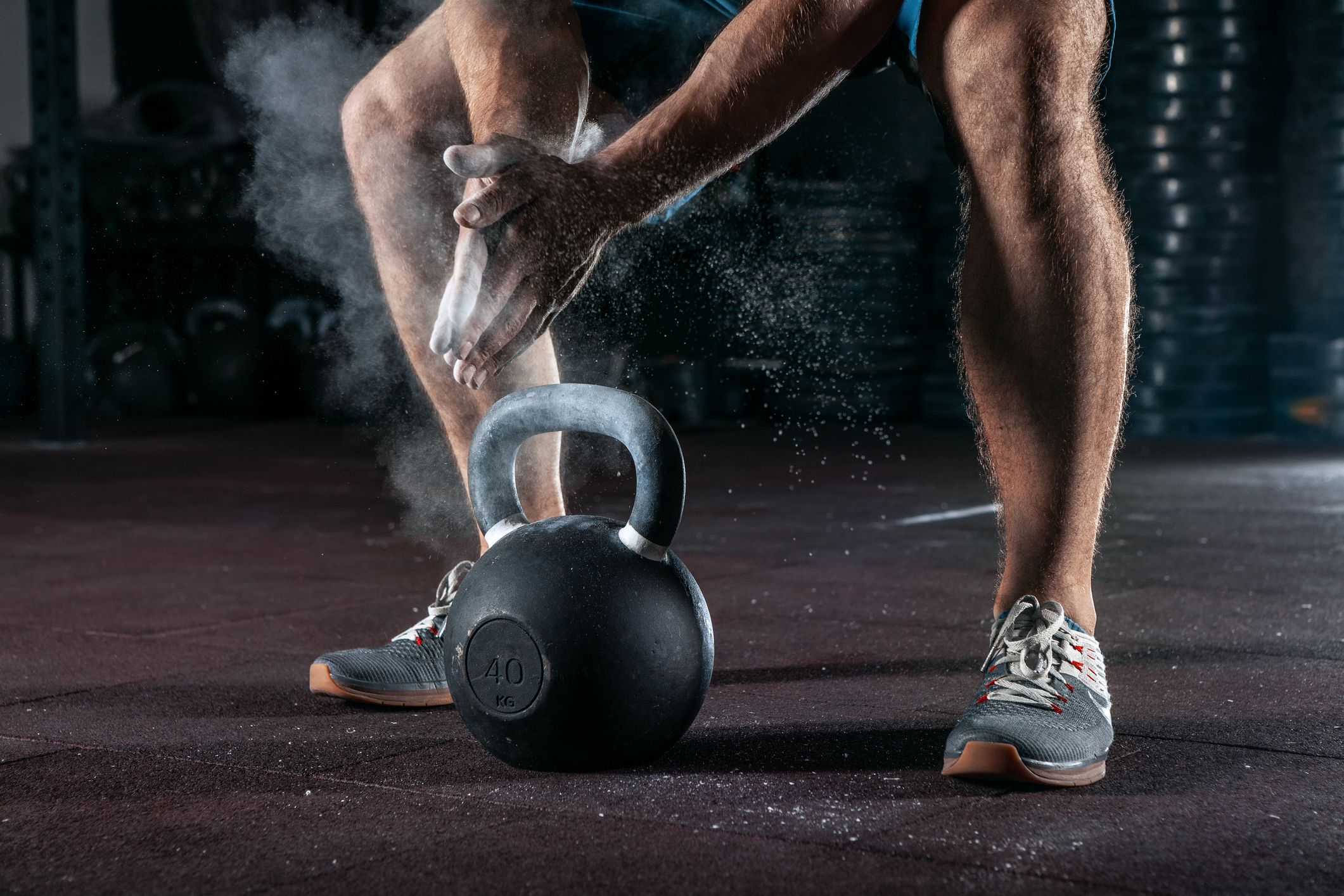What to expect in this article:
- 5 reasons why EVERYONE benefits from the kettlebell swing
Maximum body fat burning, cracking buttocks and athleticism in one - The perfect equipment
Which kettlebells last best and why quality is the key - The right kettlebell swing technique
How to learn the swing quickly and how to optimize your technique (you should avoid THESE mistakes!) - Daily Swing Challenge
How to use the kettlebell swing to instantly accelerate your body fat burning, increase your fitness and get a firm butt
The kettlebell swing – the perfect addition to your training. Few are really aware of the potential of this great exercise.
Do you want to burn body fat? Or increase your speed and explosiveness and thus your performance in other sports? Or just get a firm butt?

The kettlebell swing accelerates your progress enormously in each of these objectives!
And that is what makes an exercise fundamentally valuable: It should ideally be target-oriented on the one hand and versatile on the other.
This is what all basic exercises have in common; they serve specific training as well as general basic training.
The kettlebell swing is a prime example of this principle. It enables you to pursue aesthetic goals and improve your fitness and general athleticism at the same time.
Look fit AND be fit is the motto – a rarity!
Curious? Below you will find EVERYTHING you need to know about kettlebell swing.
These muscles are trained during the kettlebell swing
The kettlebell swing trains, if done correctly, mainly :
- Gluteus maximus (large gluteal muscle)
- Back of thigh (3 muscles in number)
- lower back
These muscle groups belong to the so-called rear kinetic chain , an often neglected but functionally extremely important part of the musculoskeletal system.
Secondly, forearms and grip strength, the shoulders and, due to the free weight, a large number of smaller secondary muscles are trained.
5 reasons why you should integrate the kettlebell swing into your training
§1: The kettlebell swing is one of the best exercises for a firm butt
Above all, a firm bum means building appropriate muscles and strengthening the gluteus maximus.
The kettlebell swing gives you three unfair advantages:
- The buttocks are trained directly. The movement consists primarily of hip extension, which makes the muscles of the buttocks the main actors.
- The mind-muscle connection to the gluteal muscles is significantly strengthened. The kettlebell swing makes it easy to specifically tense the gluteal muscles and bring them into motion. The large number of repetitions that are easily possible in this dynamic swing exercise strengthens the mind-muscle connection to the buttocks. Put simply, it will be easier for you to feel the gluteal muscles during other exercises, to activate them and to bring them into the respective movement (e.g. the barbell squat).
- The kettlebell swing can be trained daily will. If you have the technique in, you will be able to do most of the work through your glutes. These tolerate a very high frequency of stress. In addition, comparatively light weights are used, so that the central nervous system is hardly stressed.
§2: Fat burning in record time
With the kettlebell swing you train large muscles (the gluteus maximus is the largest muscle in the body in terms of volume) explosively and with many repetitions.
This is an excellent combination for getting your heart rate up and sweating a lot.
This metabolism-intensive workout is the perfect complement to strength training to burn body fat both effectively and sustainably.
The fact that you can train the kettlebell swing daily (see §1) rounds off this overall package and makes the swing one of the best supplementary exercises to gear your training towards fat burning.
I use it again and again both for myself and for my clients to push fat loss.

§3: Additional endurance training
Sure, everything that gets the metabolism going also trains endurance. Not only physically, but also mentally, because you can train very intensively with swing. HIIT, i.e. high-intensity interval training, is the keyword.
Of course, this is primarily about specific endurance , so you train your metabolism for short intensive units and not so-called General Physical Preparedness (GPP).
Circuit training and longer endurance units (jogging, swimming, cycling etc.) are therefore not replaced, but supplemented.
§4: Explosivity and speed power
First, the basic physiology of the body:
The origin of explosive power development lies in the center of the body. The further the body part is from the center, the lower its potential for explosive power development.
Perhaps you know the illustration belonging to this basic principle of explosive power development (picture on the right).
Explosiveness comes from the center of the body, which is why the hips are the crucial joint for all powerful exercises. If you want to develop a lot of strength / speed, then the hips must be decisively integrated into the movement.
Prime examples of this are the two strength classics, squats and deadlifts, which each effectively train most of the muscles in the body and enable the use of the largest possible weights.
This can also be observed well when sprinting, where the running style changes purely intuitively (compared to normal jogging) so that the hip flexors and extensors are more involved.
In soccer, a shot only gets maximum power when the hip is used. This applies to both the swing of the leg and an additional hip rotation. The knee joint only makes a very small contribution here.

The kettlebell swing is primarily about stretching the hips (extension). That is why the hip extensors (gluteus max. And back of the leg) are particularly stressed in a dynamic way
For this reason, the kettlebell swing is an excellent exercise for developing speed and explosiveness and improving your athletic performance.
§5: The rear kinetic chain – the right balance
People tend to focus more on things they can see.
That is why many focus on the so-called mirror muscles – chest, arms, stomach, front thigh muscles, shoulders.
However, the back of the body – and this particularly affects the lower back, the buttocks and the muscles of the back of the legs – is often neglected.
Whenever, however, training is too one-sided and the opponent to the preferred muscle group is neglected, imbalances arise that both inhibit performance and represent a increased risk of injury >
This has to do with how the muscles work.
You probably know that muscles can contract. This means nothing other than that the muscles contract and exert a corresponding force on the joint.
However, so that the force can also be converted constructively into the desired movement and maximum tension (force) can be generated, this pull on the joint also requires a opponent who stabilizes the joint.
If the opponent (antagonist) is too weak, the strength of the agonist is also inhibited.
In addition, over time there may be minimal displacement of the joint (which is the norm in the case of the hips due to our sedentary lifestyle!), which in turn Force can no longer be transferred properly .
By the way, this is one of the biggest limiting factors in the squat. Many wonder why the weights are not increasing as they should.
Long story short: The kettlebell swing is a great balancing movement to promote the development of important muscles in the rear kinetic chain.
Kettlebell swings in action – learn the swing and use it immediately
Are you dying to finally incorporate swing into your training? You now know that it is a damned worthwhile and versatile exercise.
But how is it actually carried out? What equipment do you need? Which training methods make the most sense?
Let’s get into the sweaty practice.
The right equipment
You need a kettlebell / kettlebell. It is true that you can theoretically do the swing with a dumbbell, but it is not the same.
With the kettlebell, the exercise is much more effective and more fun. It has a shifted center of gravity and the perfect design to really perform the swings with momentum.
This is necessary to realize the potential of the exercise. The swing enables metabolism-intensive training. After all, it’s not a strength exercise, but an excellent conditioning exercise.
I use Gorilla Sports Kettlebells myself. They are not my first, but qualitatively my best kettlebells.

As with pretty much all other fitness tools, I can only strongly advise you to invest directly in quality and get yourself a Competition Kettlebell .
It’s a lot more expensive, but it’s perfectly balanced, has the ideal form factor and lasts a lifetime!
Cheap kettlebells often have an inconvenient size, a poorly shaped handle, or an impractical weight distribution. If you want to save here, you usually buy twice. At least that’s what happened to me.
During training you feel the difference in quality over time, especially when the weights increase or you perform more complex exercises such as the snatch (the kettlebell can of course be used for far more exercises than the swing).
The versatility makes this tool particularly worthwhile, even if I honestly would have got myself my kettlebell if I could only do swings with it.
If you want to find out more about the training options with the kettlebell, the book by Johannes Kwella is ideal.
The right technique
The correct kettlebell swing technique is not complicated and is quick to learn. It is also accelerated by doing a lot of repetitions of this exercise – hence will the coordination of the swing programmed faster.
You should absolutely pay attention to these points:
- Concentrate on your hips. The knees are only slightly bent because it is not about a squat, but an explosive hip extension.
- The upper body is not actively erected. They’re not good mornings either. The upper body is straightened up indirectly by explosively pushing your butt forward.
- Keep your arms straight. Otherwise you run the risk of injuring yourself. The biceps in particular would be exposed to heavy loads.
- Maximum up to shoulder height. In the Crossfit you often see the swing with your arms fully extended. That doesn’t make any sense! It’s like combining barbell rowing with biceps curls – the curls limit rowing performance and destroy the purpose of the exercise. Swing is about the waist, not the shoulder. In addition, with this bizarre variant, where the kettlebell is lifted above the head, the risk of injury increases – unnecessarily! If the kettlebell goes too high, you are probably using weights that are too light (or see the next but one point). With the right training weight, the kettlebell reaches its highest point in the stomach / chest area. Up to the shoulders, not higher.
- Keep your back in its natural curvature. If the kettlebell sinks again, there is a risk of rounding your back. Keep its natural curvature during the entire movement !
- The arms only hold the dumbbell. The movement is not active instead of in the shoulders, but exclusively in the hips.
- Use chalk. Gloves if necessary if chalk is not allowed. You will work up a sweat during this exercise and a firm grip is the most important requirement for a safe exercise.
Metabolic Conditioning Finisher
The Swing is perfect as a workout finisher. That means, you simply attach it to a normal strength workout and thus ensure a decent afterburn effect to burn body fat.
The following repetition schemes are an example:
- EMOM: Perform every minute for 10 minutes 10 (beginner), 20 (intermediate), 30 or more (advanced) repetitions. You can then pause until the minute is full. The faster you do the swings, the longer you can pause. Incredibly intense!
- HIIT: Highly intense intervals, e.g. the well-known Tabata interval training. As many swings as possible are performed for 20s and then paused for 10s – 8 of them consecutively (so a total of 4 minutes). The intervals can of course also be divided differently, e.g. Swings for 30s followed by a 30s break for 10 rounds.
- Swing Burpee Showdown: One after the other 21 swings + 21 burpees + 18 swings + 18 burpees + 15 swings + 15 burpees + 12 swings + 12 burpees + 9 swings + 9 burpees + 6 swings + 6 burpees + 3 swings + 3 burpees. As soon as possible, stop the time. If you don’t bathe in sweat afterwards, you’ve done something wrong.

Daily Swing Challenge
You have already learned why the swing can also be trained daily. This is exactly what I like to use myself to program my body to burn fat.
It is also a very useful tool for clients who want to lose those last and most stubborn pounds on six packs .
The Daily Swing Challenge is just as suitable for female clients who want to build a tight ass .
The challenge: Swings every morning immediately after getting up for 30 days.
The number of total repetitions must be adjusted to your fitness level. Useful orientation:
- Beginner – 100 reps, increase by 5 per day
- Intermediate – 200 reps, increase by 10 per day
- Advanced – 300 reps, increase by 15 per day
It could look like this: 100 swings on the first day, 105 swings on the second day, 110 swings on the third day, ….
You can pause as often as necessary, but as little as possible. It should stimulate your metabolism and be challenging (but not overwhelming).
Incidentally, this does not count as an independent training, but is a supplement to your normal training that can be continued normally. So to speak, a upgrade for burning fat or to tighten your buttocks.
By the way: beginners should first internalize the technique before starting the challenge. 2 weeks of 3 units with swings are sufficient as preparation, to learn the sequence of movements and to prepare the body for the specific load.
A decisive factor is of course the correct diet if you want to burn body fat.
But if you have that under control, you can effectively burn body fat with the Daily Swing Challenge and see clearly visible progress after just 30 days.

